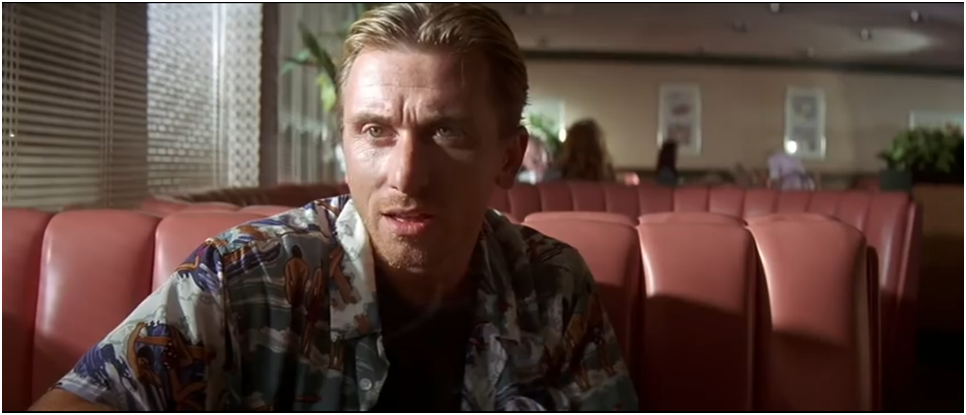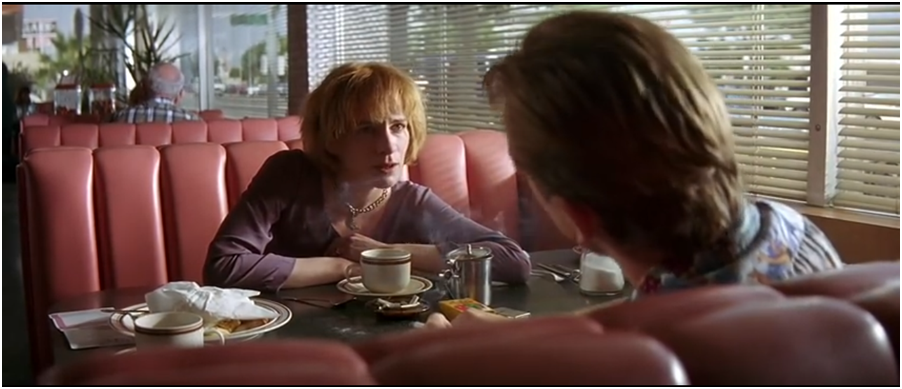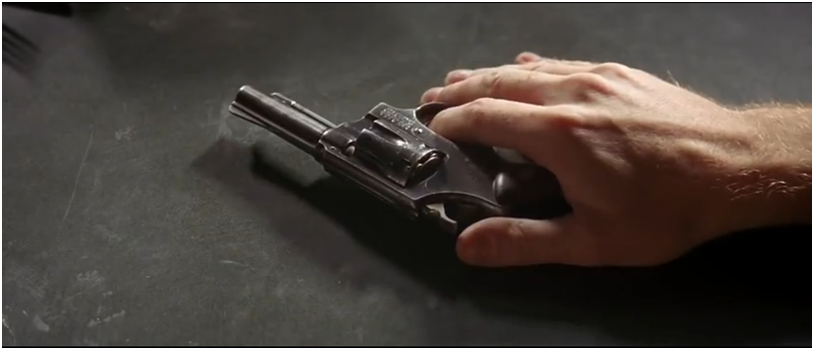Pulp Fiction (1994): http://www.imdb.com/title/tt0110912/
Director: Quentin Tarantino
Writers: Roger Avary, Quentin Tarantino
Pulp Fiction is an iconic film for its non-linear plot and marriage of both violence and comedy. The film challenges many conventions of typical thriller films and could be an interesting approach to my own opening sequence.
The film begins with a fade into a dictionary definition of the word 'pulp'. Since the film is named Pulp Fiction the second definition is more relevant to the themes present in the film. However this first meaning could have some significance, which will be discussed later.
The definition is taken from 'American Heritage Dictionary' immediately setting the place for the film. This is further established as the screen dissolves into a two shot of a couple sitting in a diner, an iconic American setting. However a diner is very unusual setting for a conversation like the two are having, one example of conventions being broken. Here is the opening scene, (not including the definition or opening titles):
The couple are seen conversing with each other, the dialogue is dominated by the male. This may also explain why the shot is angled towards the man despite being a two shot.
This mid-shot introduces two major characters to the audience. The male with the British accent is leaning back and has quite open body language. He is also smoking a cigarette and swears generously, suggesting that he is at ease and currently quite relaxed in the presence of the woman opposite. Due to the topic of conversation the man can be recognised as a rebellious figure, however his costume does not reflect this. The costume is casual, relaxed and blends in with the hot American setting. He almost looks like a tourist, perhaps aided by the British accent in an American setting.
The woman contrasts the man as she is sitting straight up, perhaps implying that she is awed by the man's presence. It may also be that she displays better manners and can more easily create a facade than the man, as demonstrated later on in the scene at 0:36-0:42. The woman's American accent is comparatively sweet and seems a slightly out of place in such a conversation. Her costume emphasises the 'cutesy' perception as she wears a pink dress and natural, minimal looking make-up. Another interpretation could be that she has split-personality tendencies, having a quirky and cutesy side (such as 'Quack, quack, quack...' at 0:22-0:25) and a more violent side seen at the end of the clip.
When the waitress arrives at 0:35 the conversation between the couple stops. This emphasises that their conversation, although not so much at this point, is not for anybody else ears due to their bad intentions. Comedy can be created form this as despite the private nature of their conversation, they are talking in a public place. The woman turns to the waitress and acts very gratefully saying 'Thank you' followed by a cutesy shrug. The scene is uncomfortable to watch as the level of appreciation the woman is giving is unnecessary and suggests that she may be someone who has many sides to her personality and can change between them very quickly. It also suggests that she has something to hide, thus creating the need for her to do this. Although probably added more for comedic purposes, the theory that she may have something to hide and is troubled by this could be supported by her over-indulgence in sugar during 0:49-0:52 and her hands over her face before this, as if she is worn out from acting friendly with the waitress.
After the waitress has left the male gets onto the topic of bank robberies, clearly a topic he is very fond and passionate about, revealed by his body language. He leans forwards and uses his hand gestures on the table. This is contrasted to the previously relaxed position he was in before this point. The woman holds his gaze whilst adjusting her coffee, showing interest too. Apart from being passionate about the subject the leaning towards each other also indicates that their conversation is not to be heard by other people.
After this two shot a straight cut is made to several shot-reverse-shot sequences, sometimes incorporating over-the-shoulder shots and always returning to a two shot in between sequences.
For the first shot-reverse-shot sequence, beginning at 0:58, the shots of the woman are regular mid-shots and the previous waitress visible in the background.
The shots of the male however are over-the-shoulder shots of the woman. This could be to demonstrate that the conversation is being held mainly by the male and so the female is listening very intently. During the same conversation a cut is made back to the original two shot and the woman asks 'did they hurt the little girl?' A close up of her face is not shown, emphasising how trivial the question sounds based on the conversation and in the eyes of the man. This question also strengthens her innocent persona.
The second shot-reverse-shot sequence starts at 1:28 and like the previous one it starts with the camera on the female. The difference this time is that the female put forward a meaningful question in relation to the story, in contrast to being a listener previously. The next shot of the male is not shrouded by a shoulder this time, as if he is not fully in control of the conversation anymore and/or been put on the spot due to the unexpected question. This is emphasised by the fact that the shot is not off centre like the previous ones and the man's somewhat shocked facial expression. The words 'no more liquor stores?' confirm that the two are partners in crime and it is a common occurrence.
After once again returning to the off centre two shot at 1:38 the male says 'too many foreigners own liquor stores'. This suggests again that he is not a friendly character and the conversation proves that he is involved in illegal actions.
The cutesy characteristic assigned to the female can once again be seen at 1:50 as the female states 'I'm not going to kill anybody'. This clashes with her iconic line at the end of this scene. She says it very sweetly and innocently, perhaps trying to outweigh the tougher character she showed when participating in the conversation about robberies. The scene is an over-the-shoulder shot from the male perspective. This could symbolise that the male can be easily swayed by the female when she acts like this.
At 1:53 the first non-static shot appears in the clip so far. The camera moves forwards, starting from an over-the-shoulder shot of the male, and moving past it. This is whilst he talks about being in a situation where he may need to kill someone. The zoom could be to draw attention to this and perhaps foreshadow to suggest that the man may end up in a situation like this.
From 2:30 onwards the most of the scene is made up of shot-reverse-shots, using straight on mid-shots of the male and off centre mid-shots of the female. This is again due to the male dominating the conversation. This is due to the intimacy of their conversation whilst they are contemplating robbing 'this coffee shop'. This is further emphasised by the male lowering his voice at 3:26.
Although the logic of the robbery seems flawed, the female eventually jumps on board. He praises her for her idea of 'taking their wallets', and she replies with a smile and 'thank you' at 3:36. This could be the male accepting the female as an equal partner in crime. During the course of the conversation the female becomes more and more aggressive, initiating the robbery by saying 'I'm ready, let's do it, right now, right here'.
A close up of the gun slammed onto the table is seen. This is to draw attention to the weapon, another convention of thriller films, and to inform the audience that the robbery is underway. The man, taking the lead again, hands out the roles and the two rush into a somewhat sloppy looking kiss. This is as the scene has picked up the pace and the nature of their relationship is clarified, even more so by the nicknames 'pumpkin' and 'hunny bunny'.
The man stands up first, declaring a robbery. The camera tilts upwards from a longer distance two shot. The woman, coming out of her shell, also pulls out a gun, unexpectedly, and moves to the foreground of the shot, taking control. As part of her iconic line, she says 'I'll execute every motherf***ing last one of you' - the complete opposite of 'I'm not going to kill anybody' mere minutes before.
The recognisable music starts as the screen freeze frames and the opening titles begin to appear. Here is the title sequence:
The opening titles in this case are separate and not incorporated into the story section of the opening sequence. First appear the production companies, in orange, and the director's name, also in orange. This colour stands out on the black background and ties in with the titles, which scrolls upwards at 0:17. This orange colour could also be a reference right from the beginning of the clip to the first dictionary definition of 'pulp', like from an orange fruit.
The main actors then appear upon the screen, on by one, whilst the titles slowly shrinks into the background. The colour of these actors is white, to separate itself from the black and orange already present.
At 1:15 'co-starring' appears on the screen, in orange, as by this point the title has disappeared. Then several names scroll upwards. This scrolling of names is unusual for a title sequence and is conventionally used in the end credits. Yet another way this films breaks conventions.
From 1:31 onwards many of the names appear in pairs or groups, as they are less prominent and will most likely not mean much to the audience.
At 1:34 the music becomes disported and as if 'someone' has changed the radio station. A more upbeat and relaxed tune follows and this music remains for the rest of the sequence.
Here is the opening titles in text format as they appear:
Miramax Films presents
A Band Apart
and Jersey Films Productions
a film by Quentin Tarantino
Pulp Ficition
(Actors) John Travolta
Samuel L. Jackson
Uma Thurman
Harvey Keitel
Tim Roth
Amanda Plummer
Maria de Medeiros
Ving Rhames
Eric Stoltz
Rosanna Arquette
Christopher Walken
and Bruce Willis
co-starring
Paul Calderon
Bronagh Gallagher
Peter Greene
Stephen Hibbert
Angela Jones
Phil LaMarr
Robert Ruth
Julia Sweeney
Quentin Tarantino
Frank Whaley
Duana Whitaker
Casting by Ronnie Yeskel C.S.A (and) Gary M. Zuckerbrod C.S.A
Music Supervisor Karyn Rachtman
Costume Designer Betsy Heimann
Production Designer David Wasco
Editor Sally Menke
Director of Photography Andrzej Sekula
Co-Executive Producers Bob Weinstein, Harvey Weinstein (and) Richard N. Gladstein
Executive Producers Danny DeVito, Michael Shamberg (and) Stacy Sher
Stories by Quentin Tarantino & Roger Avary
Produced by Lawrence Bender











No comments:
Post a Comment